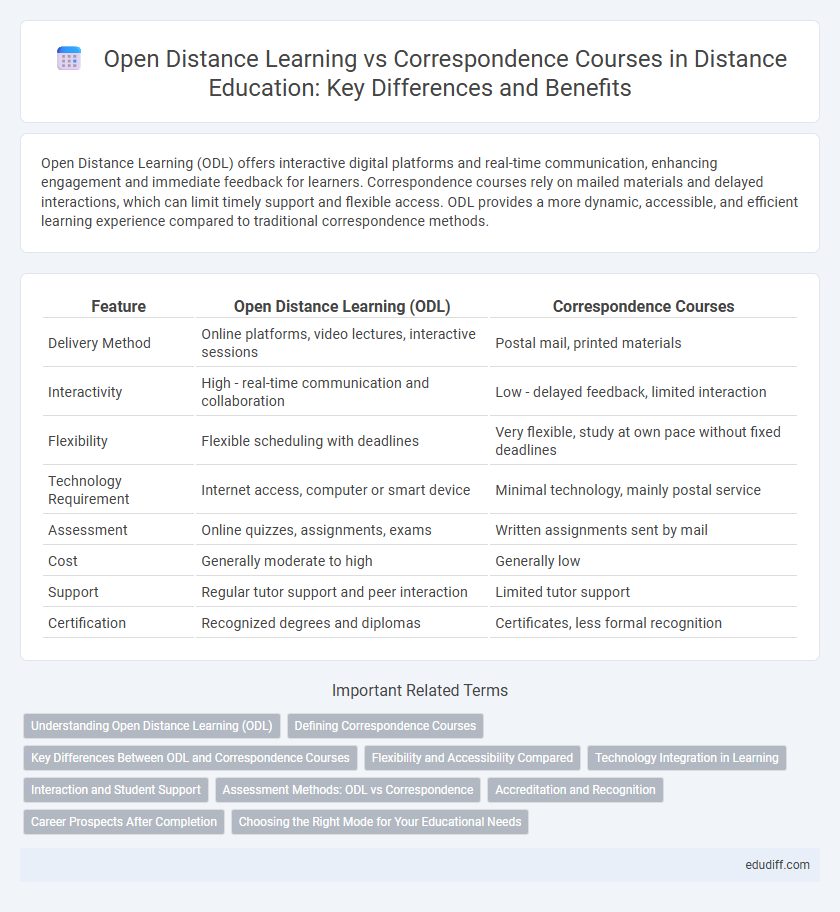Open Distance Learning (ODL) offers interactive digital platforms and real-time communication, enhancing engagement and immediate feedback for learners. Correspondence courses rely on mailed materials and delayed interactions, which can limit timely support and flexible access. ODL provides a more dynamic, accessible, and efficient learning experience compared to traditional correspondence methods.
Table of Comparison
| Feature | Open Distance Learning (ODL) | Correspondence Courses |
|---|---|---|
| Delivery Method | Online platforms, video lectures, interactive sessions | Postal mail, printed materials |
| Interactivity | High - real-time communication and collaboration | Low - delayed feedback, limited interaction |
| Flexibility | Flexible scheduling with deadlines | Very flexible, study at own pace without fixed deadlines |
| Technology Requirement | Internet access, computer or smart device | Minimal technology, mainly postal service |
| Assessment | Online quizzes, assignments, exams | Written assignments sent by mail |
| Cost | Generally moderate to high | Generally low |
| Support | Regular tutor support and peer interaction | Limited tutor support |
| Certification | Recognized degrees and diplomas | Certificates, less formal recognition |
Understanding Open Distance Learning (ODL)
Open Distance Learning (ODL) leverages digital technology and online platforms to deliver educational content, enabling flexible access to courses anytime and anywhere. Unlike traditional Correspondence Courses that rely primarily on postal mail for material distribution and submission, ODL incorporates interactive multimedia, virtual classrooms, and real-time communication tools to enhance learner engagement. This modern approach bridges geographical gaps and provides scalable education solutions tailored to diverse student needs.
Defining Correspondence Courses
Correspondence courses are a form of distance education where instructional materials, assignments, and exams are exchanged between students and instructors primarily through mail or email, allowing learners to study independently at their own pace. These courses emphasize asynchronous communication and self-directed learning without real-time interaction or virtual classrooms commonly found in open distance learning. Correspondence education typically provides structured curricula with clear deadlines but lacks the multimedia and collaborative tools integral to modern online open distance learning platforms.
Key Differences Between ODL and Correspondence Courses
Open Distance Learning (ODL) offers interactive, technology-driven education with real-time communication between students and instructors, whereas correspondence courses rely on mailed or electronic materials with limited interaction. ODL provides structured schedules, multimedia content, and online assessments, supporting a more engaging and flexible learning experience compared to the self-paced, resource-based approach typical of correspondence courses. Key differences include ODL's emphasis on immediate feedback and collaborative learning environments, contrasting with correspondence courses' focus on independent study and periodic submission of assignments.
Flexibility and Accessibility Compared
Open Distance Learning provides greater flexibility by offering real-time interaction and digital access to course materials anytime and anywhere, enabling students to balance studies with personal commitments efficiently. Correspondence Courses rely on physical mail delivery, which limits immediacy and restricts accessibility due to slower communication and dependence on postal services. The digital infrastructure of Open Distance Learning significantly enhances accessibility for learners across diverse geographic locations compared to traditional Correspondence Courses.
Technology Integration in Learning
Open Distance Learning leverages advanced digital platforms and interactive tools to facilitate real-time communication, multimedia content delivery, and personalized learning experiences. Correspondence courses primarily rely on mailed materials and limited technology integration, resulting in delayed feedback and less dynamic interaction. The integration of learning management systems, video conferencing, and mobile applications distinguishes Open Distance Learning by enhancing accessibility and engagement.
Interaction and Student Support
Open Distance Learning offers enhanced interaction through real-time virtual classrooms, discussion forums, and multimedia communication, fostering active student engagement and collaborative learning. In contrast, Correspondence Courses primarily rely on mailed materials or emails, limiting immediate feedback and peer interaction, which can affect the learning experience. Robust student support services, such as online tutoring and academic advising, are integral to Open Distance Learning, whereas Correspondence Courses often provide more minimal support due to their asynchronous nature.
Assessment Methods: ODL vs Correspondence
Open Distance Learning (ODL) typically employs interactive assessment methods such as online quizzes, video submissions, and real-time discussions to evaluate student understanding, promoting immediate feedback and adaptive learning. Correspondence courses primarily rely on mailed assignments and written exams with delayed feedback, limiting opportunities for timely clarification and engagement. The use of digital platforms in ODL enhances assessment flexibility and accuracy compared to the traditional, paper-based evaluation system of correspondence education.
Accreditation and Recognition
Open Distance Learning (ODL) programs typically have accreditation from recognized educational authorities, ensuring their qualifications are widely accepted by employers and institutions. Correspondence courses may vary in accreditation status, often lacking formal recognition, which can limit their credibility and transferability in professional and academic settings. Evaluating the accreditation and recognition of distance education providers is crucial for validating the quality and acceptance of the issued certifications.
Career Prospects After Completion
Open distance learning programs often provide interactive platforms, up-to-date curricula, and industry-relevant skills that enhance employability and career advancement opportunities. Correspondence courses, while flexible, may lack real-time engagement and modern content delivery, potentially limiting immediate job market readiness. Employers increasingly favor candidates from accredited open distance learning institutions due to their practical knowledge and adaptability.
Choosing the Right Mode for Your Educational Needs
Open Distance Learning offers interactive online platforms and real-time communication, providing flexibility and immediate feedback, ideal for learners seeking engagement and technological integration. Correspondence Courses rely on mailed materials and self-paced study, suitable for students with limited internet access or those preferring traditional methods. Evaluating factors like access to technology, learning style, and schedule flexibility helps determine the most effective mode for individual educational needs.
Open Distance Learning vs Correspondence Courses Infographic

 edudiff.com
edudiff.com